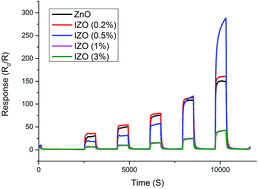Enhanced gas sensing performance of indium doped zinc oxide nanopowders
Abstract
A series of indium doped ZnO (IZO) materials were fabricated, characterised and tested for their gas sensing properties. ZnO was synthesised with indium doping levels of 0.2, 0.5, 1 and 3 mol%. These were fabricated into gas sensors. Production took place using a commercially available screen printer, a 3 × 3 mm alumina substrate containing interdigitated electrodes and a platinum heater track. Materials were characterised using X-ray diffraction (XRD), scanning electron microscopy (SEM) and energy dispersive X-ray spectroscopy (EDX). Electrical conductivity of all samples was also calculated. Sensors were exposed to ethanol, methanol, n-butanol and acetone at concentrations between 5 and 80 ppm. Low levels of indium doping were found to increase the responsiveness of the sensors. However, higher levels of doping were found to inhibit conductivity and responsiveness to gases of IZO sensors. Sensors with low levels of indium doping were found to show minimal response to other gases, demonstrating a lack of cross sensitivity. These sensors show potential for inclusion into an electronic nose for with the aim of selective alcohol detection.


 Please wait while we load your content...
Please wait while we load your content...